How To Find The Value Of A Triangle
Triangle Reckoner
Please provide three values including at least one side to the following half-dozen fields, and click the "Calculate" push button. When radians are selected as the angle unit, it can take values such every bit pi/2, pi/iv, etc.
| | | |||
| Bending Unit: | ||||
 | ||||
A triangle is a polygon that has three vertices. A vertex is a point where ii or more curves, lines, or edges encounter; in the instance of a triangle, the three vertices are joined by iii line segments called edges. A triangle is usually referred to by its vertices. Hence, a triangle with vertices a, b, and c is typically denoted as Δabc. Furthermore, triangles tend to be described based on the length of their sides, also as their internal angles. For example, a triangle in which all three sides have equal lengths is called an equilateral triangle while a triangle in which 2 sides accept equal lengths is called isosceles. When none of the sides of a triangle have equal lengths, information technology is referred to as scalene, as depicted below.

Tick marks on the edge of a triangle are a common annotation that reflects the length of the side, where the same number of ticks means equal length. Similar notation exists for the internal angles of a triangle, denoted by differing numbers of concentric arcs located at the triangle'due south vertices. As can exist seen from the triangles above, the length and internal angles of a triangle are directly related, so it makes sense that an equilateral triangle has 3 equal internal angles, and three equal length sides. Note that the triangle provided in the calculator is not shown to scale; while it looks equilateral (and has angle markings that typically would exist read equally equal), it is non necessarily equilateral and is just a representation of a triangle. When actual values are entered, the calculator output will reflect what the shape of the input triangle should wait like.
Triangles classified based on their internal angles fall into two categories: right or oblique. A right triangle is a triangle in which ane of the angles is xc°, and is denoted past two line segments forming a square at the vertex constituting the right angle. The longest border of a right triangle, which is the edge contrary the correct angle, is called the hypotenuse. Any triangle that is not a right triangle is classified every bit an oblique triangle and tin either be obtuse or astute. In an obtuse triangle, one of the angles of the triangle is greater than 90°, while in an acute triangle, all of the angles are less than 90°, equally shown below.

Triangle facts, theorems, and laws
- Information technology is not possible for a triangle to accept more than one vertex with internal bending greater than or equal to 90°, or it would no longer be a triangle.
- The interior angles of a triangle ever add upward to 180° while the outside angles of a triangle are equal to the sum of the 2 interior angles that are not adjacent to information technology. Another style to calculate the outside angle of a triangle is to subtract the angle of the vertex of interest from 180°.
- The sum of the lengths of whatever two sides of a triangle is always larger than the length of the third side
- Pythagorean theorem: The Pythagorean theorem is a theorem specific to right triangles. For whatever right triangle, the foursquare of the length of the hypotenuse equals the sum of the squares of the lengths of the two other sides. It follows that any triangle in which the sides satisfy this condition is a correct triangle. There are also special cases of right triangles, such as the 30° 60° xc, 45° 45° ninety°, and 3 4 5 right triangles that facilitate calculations. Where a and b are two sides of a triangle, and c is the hypotenuse, the Pythagorean theorem can be written every bit:
atwo + b2 = c2
EX: Given a = three, c = 5, find b:
32 + b2 = 52
nine + b2 = 25
b2 = sixteen => b = iv - Law of sines: the ratio of the length of a side of a triangle to the sine of its reverse angle is abiding. Using the constabulary of sines makes it possible to find unknown angles and sides of a triangle given enough information. Where sides a, b, c, and angles A, B, C are as depicted in the above reckoner, the police of sines can be written as shown below. Thus, if b, B and C are known, it is possible to find c by relating b/sin(B) and c/sin(C). Note that at that place exist cases when a triangle meets certain conditions, where two different triangle configurations are possible given the same fix of information.
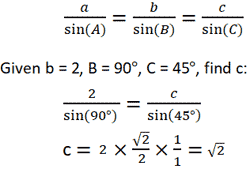
- Given the lengths of all three sides of whatever triangle, each bending tin can be calculated using the following equation. Refer to the triangle higher up, assuming that a, b, and c are known values.
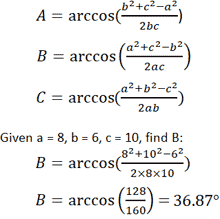
Area of a Triangle
In that location are multiple unlike equations for calculating the expanse of a triangle, dependent on what data is known. Probable the most normally known equation for calculating the area of a triangle involves its base of operations, b, and height, h. The "base" refers to any side of the triangle where the acme is represented by the length of the line segment drawn from the vertex opposite the base, to a point on the base that forms a perpendicular.
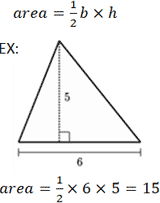
Given the length of 2 sides and the bending between them, the post-obit formula tin be used to decide the area of the triangle. Notation that the variables used are in reference to the triangle shown in the computer above. Given a = 9, b = 7, and C = 30°:
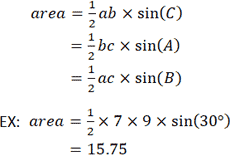
Some other method for calculating the area of a triangle uses Heron's formula. Unlike the previous equations, Heron's formula does not crave an arbitrary choice of a side every bit a base, or a vertex as an origin. However, it does require that the lengths of the three sides are known. Again, in reference to the triangle provided in the calculator, if a = three, b = four, and c = 5:

Median, inradius, and circumradius
Median
The median of a triangle is divers equally the length of a line segment that extends from a vertex of the triangle to the midpoint of the opposing side. A triangle can accept iii medians, all of which will intersect at the centroid (the arithmetic mean position of all the points in the triangle) of the triangle. Refer to the figure provided below for clarification.

The medians of the triangle are represented past the line segments chiliada, thoub, and 1000c. The length of each median can be calculated every bit follows:
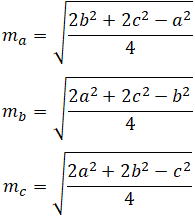
Where a, b, and c represent the length of the side of the triangle as shown in the figure to a higher place.
As an case, given that a=2, b=three, and c=4, the median ga tin be calculated as follows:

Inradius
The inradius is the radius of the largest circumvolve that volition fit inside the given polygon, in this instance, a triangle. The inradius is perpendicular to each side of the polygon. In a triangle, the inradius can be adamant past amalgam two angle bisectors to determine the incenter of the triangle. The inradius is the perpendicular distance between the incenter and one of the sides of the triangle. Any side of the triangle tin can exist used as long as the perpendicular distance betwixt the side and the incenter is determined, since the incenter, by definition, is equidistant from each side of the triangle.

For the purposes of this figurer, the inradius is calculated using the area (Expanse) and semiperimeter (s) of the triangle along with the following formulas:
where a, b, and c are the sides of the triangle
Circumradius
The circumradius is defined as the radius of a circle that passes through all the vertices of a polygon, in this case, a triangle. The center of this circle, where all the perpendicular bisectors of each side of the triangle meet, is the circumcenter of the triangle, and is the point from which the circumradius is measured. The circumcenter of the triangle does non necessarily have to be within the triangle. It is worth noting that all triangles have a circumcircle (circle that passes through each vertex), and therefore a circumradius.

For the purposes of this calculator, the circumradius is calculated using the post-obit formula:
Where a is a side of the triangle, and A is the angle opposite of side a
Although side a and bending A are being used, any of the sides and their respective opposite angles can exist used in the formula.
Source: https://www.calculator.net/triangle-calculator.html
Posted by: hawkinsconory1967.blogspot.com


0 Response to "How To Find The Value Of A Triangle"
Post a Comment